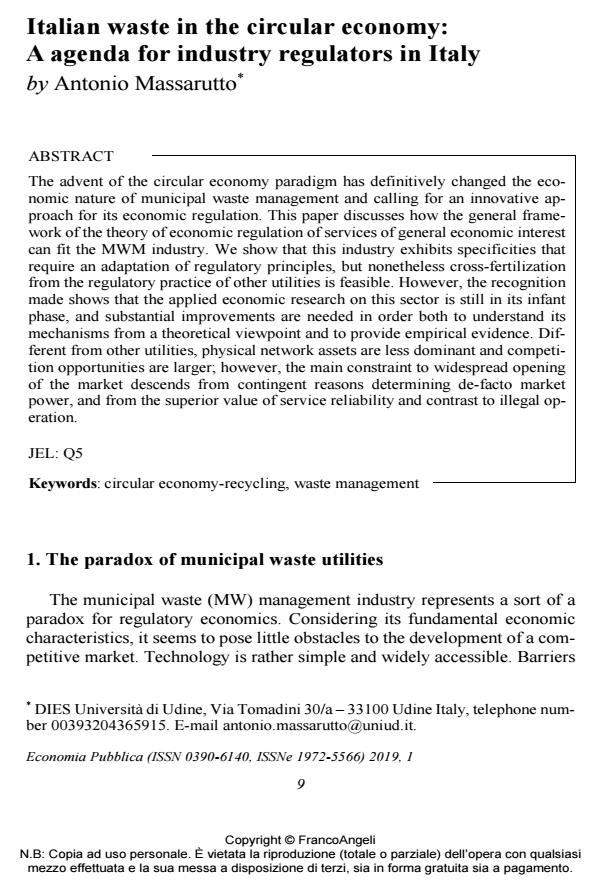Italian waste in the circular economy: A agenda for industry regulators in Italy
Titolo Rivista ECONOMIA PUBBLICA
Autori/Curatori Antonio Massarutto
Anno di pubblicazione 2019 Fascicolo 2019/1
Lingua Inglese Numero pagine 40 P. 9-48 Dimensione file 353 KB
DOI 10.3280/EP2019-001002
Il DOI è il codice a barre della proprietà intellettuale: per saperne di più
clicca qui
Qui sotto puoi vedere in anteprima la prima pagina di questo articolo.
Se questo articolo ti interessa, lo puoi acquistare (e scaricare in formato pdf) seguendo le facili indicazioni per acquistare il download credit. Acquista Download Credits per scaricare questo Articolo in formato PDF

FrancoAngeli è membro della Publishers International Linking Association, Inc (PILA)associazione indipendente e non profit per facilitare (attraverso i servizi tecnologici implementati da CrossRef.org) l’accesso degli studiosi ai contenuti digitali nelle pubblicazioni professionali e scientifiche
The advent of the circular economy paradigm has definitively changed the economic nature of municipal waste management and calling for an innovative approach for its economic regulation. This paper discusses how the general framework of the theory of economic regulation of services of general economic interest can fit the MWM industry. We show that this industry exhibits specificities that require an adaptation of regulatory principles, but nonetheless cross-fertilization from the regulatory practice of other utilities is feasible. However, the recognition made shows that the applied economic research on this sector is still in its infant phase, and substantial improvements are needed in order both to understand its mechanisms from a theoretical viewpoint and to provide empirical evidence. Different from other utilities, physical network assets are less dominant and competition opportunities are larger; however, the main constraint to widespread opening of the market descends from contingent reasons determining de-facto market power, and from the superior value of service reliability and contrast to illegal operation.
Parole chiave:Circular economy-recycling, waste management
Jel codes:Q5
- A new framework for policy evaluation: Targets, marine litter, Italy and the Marine Strategy Framework Directive Piero Morseletto, in Marine Policy 103956/2020 pp.103956
DOI: 10.1016/j.marpol.2020.103956 - Economic regulation of waste management utilities: Taking stock of the Italian reform Antonio Massarutto, in ECONOMICS AND POLICY OF ENERGY AND THE ENVIRONMENT 2/2021 pp.5
DOI: 10.3280/EFE2020-002001 - Monetary evaluation in LCA of WM: Everything engineers always wanted to know about it (but were afraid to ask) Antonio Massarutto, in Waste Management /2024 pp.12
DOI: 10.1016/j.wasman.2024.02.018 - Regulation and competition in the extended producer responsibility models: Results in the WEEE sector in Europe Marinella Favot, Luca Grassetti, Antonio Massarutto, Raphael Veit, in Waste Management /2022 pp.60
DOI: 10.1016/j.wasman.2022.04.027
Antonio Massarutto, Italian waste in the circular economy: A agenda for industry regulators in Italy in "ECONOMIA PUBBLICA " 1/2019, pp 9-48, DOI: 10.3280/EP2019-001002